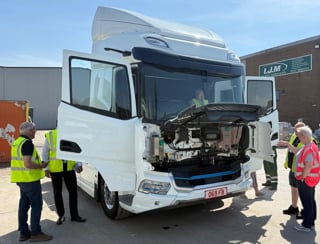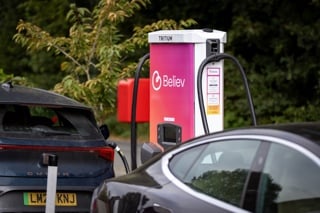The public charging infrastructure is often touted as one of the issues holding back electric vehicle adoption, but the industry smashed through a significant milestone earlier this month.
According to figures from Zapmap, the UK has just seen its 50,000th charging device deployed, with the organisation predicting it is likely to hit 100,000 in August 2025.
“We are in a completely different world to where we were just over two years ago,” says Ian Johnston, chair of recently-formed charge point industry body ChargeUK.
“At the end of 2020, after 10 years of deployment, we had 20,000 chargers. Today, we have hit 50,000.
“In the past 12 months alone, the public charge point network has increased by 43%.
“However, we can go further and faster with the right policies and help from government to remove barriers that constrain the roll-out.”
ChargeUK was launched in April this year with the aim of bringing together the largest companies installing public charge points to work collaboratively with government and other stakeholders to break down barriers and shape the policies and regulation needed to enable the transition to EVs.
“Its formation is a demonstration of the vehicle charging industry’s growing size and importance to the UK economy,” adds Johnston, who is also CEO of Osprey Charging Network.
Between them, ChargeUK’s 24 members, which include industry heavyweights such as Osprey, bp pulse and Gridserve, have announced they will invest more than £6 billion installing and operating new EV charging infrastructure by 2030.
This means the private sector is largely delivering the mass deployment of charge points in collaboration with retail, greenfield and brownfield land owners, says Johnston.
“You’ve now got this incredibly competitive industry, where the bar is being raised every day on reliability, accessibility and roaming, and you have professional nationwide networks delivering what consumers want, backed up by the new consumer regulations, which are imperative to give the consumer confidence,” he adds.
Many of the major recent investments have been in charging hubs offering eight, 16, 24 or even more charge points at one site, which is a huge change from the strategies just a few years ago of installing just one or two units.
A recent example of this is the bp pulse hub at the NEC Birmingham hub – the UK’s largest - which has the ability to charge 180 EVs at the same time and is equipped with 30 ultra-fast 300kW DC chargers and 150 7kW points.
Gridserve, meanwhile, hit the milestone in August of having 50 new Electric Super Hubs built or in construction.
The company also has “dozens” of additional sites being prepared for production for the facilities, which typically include 350kW high power charge points.
“We now seem to be seeing a new, large rapid hub being delivered every week across the UK,” says Johnston. “As well as really ramping up the volume of chargers, it increases the availability and flexibility as well.
“Whether you're a retail driver or a fleet driver, what you want is that assurance that when you drive to a site you'll be able to get on the charger.
“We know that people are happy to charge at a slightly slower rate if they can plug in quicker.
“When you're building bigger hubs, it also gives the charge point operator the opportunity to look to winning business from fleets or for certain corporate accounts.
“Already today we have the projects and the technology to introduce things like bookings, and there are sites being built now where we will have great van and HGV accessibility.
“But the problem is, at the same time, we're trying to dumb down how charging works for consumers through the consumer regulations which are trying to simplify things.
“So a big challenge for us when we're trialling reservations will be what is the etiquette? What do we do with penalties? How do we fine people?
“There needs to be more collaboration between the charging networks and the fleets to make this happen.”
However, while the overall number of public charge points races ahead, figures from the Department for Transport show their distribution is far from even.
Overall, the number of public charging devices per 100,000 of population for the whole of UK is 66, but this varies wildly between different regions.
For example, London has the highest concentration at 152 per 100,000 population followed by Scotland with 73.
Northern Ireland had the lowest level of charging device provision in the UK, with 23 devices per 100,000 population, followed by the North West with 39 and East Midlands with 43.
Johnston stresses this geographical disparity is not because charge point operators are selective about which areas they will install infrastructure in as there is a desire from the private sector to cover all of the UK by itself.
“However, there are some pockets left where it can’t,” he adds. “It absolutely isn’t the case of the charging industry only investing in regions where it’s profitable today, because there is no region which is profitable today.
“We are investing years ahead of the market, spending literally billions of pounds.”
Instead, the areas in which there are not sufficient charge points will be addressed by local authority government processes, such as the Government’s Local Electric Vehicle Infrastructure (LEVI) fund, says Johnston.
This is a £400 million capital grant scheme which is designed to support local authorities in England to work with the charge point industry to improve the roll out and commercialisation of local charging infrastructure for residents without off-street parking.
DfT’s figures also highlight the location types of charger installed: 48% are destination, 34% are on-street, 7% are en-route and 11% other. The number of ultra-rapid charge points has increased by 68% over the past year.
“Public chargers are part of a wider picture,” says Johnston. “The way people charge their EV depends on their lifestyle, many people charge at home, others charge on their street, while many will either charge at destinations or en route on their journeys.
“Our members are focused on ensuring drivers have access to the right charger in the right place.”

























martinwinlow - 17/11/2023 09:44
Anyone referring to (EV) 'chargers' without specifying their capability is just spouting hot air as there is all the difference in the world between an AC 3.6kW street-side device and a DC one capable of delivering 150kW! What we *need* at this point is many, many more of the latter (including at least one if not 2 in every single existing petrol station with more than 4 pumps) and to make them *all* credit-card compatible *and* maintain them. Waffle about anything else is completely pointless.